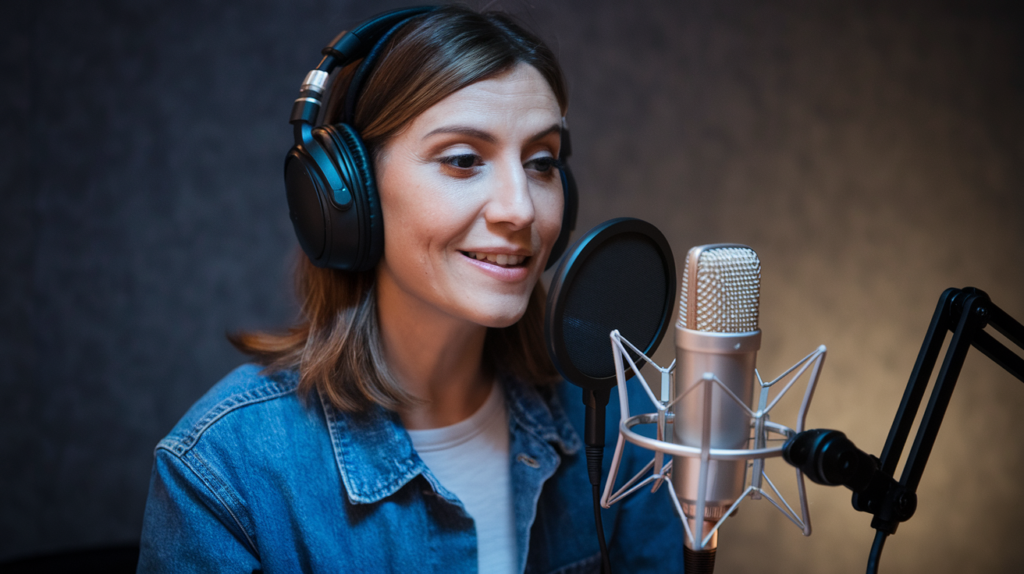Key Takeaways
- Achieving lip sync accuracy is essential in Italian dubbing to enhance viewer immersion and enjoyment, preventing distractions from mismatched dialogue.
- The selection of skilled voice talent significantly impacts the quality of dubbing, as they convey emotional nuances that enrich storytelling.
- Dubbing artists face challenges such as adapting scripts while maintaining meaning and timing, requiring creativity and adaptability for successful performances.
- Effective techniques like audio-visual synchronization and dialogue adjustment help ensure that voiceovers align seamlessly with character movements on screen.
- Technology, including advanced software tools and machine learning applications, streamlines the dubbing process, improving efficiency and precision in achieving lip sync accuracy.
Ever watched an Italian movie and felt something was off with the voices? Achieving lip sync accuracy in Italian dubbing is crucial for a seamless viewing experience. When dialogue doesn’t match what you see on screen, it can pull you right out of the story.
Overview of Italian Dubbing
Italian dubbing plays a crucial role in bringing foreign films to local audiences. It involves replacing the original dialogue with voiceover artists who deliver lines that match the characters’ emotions and actions. This process ensures viewers enjoy a seamless experience, fully immersed in the story without distractions.
Achieving lip sync accuracy is vital during this process. Mismatched dialogue can disrupt the flow of a film, pulling viewers out of the narrative and diminishing their overall enjoyment. Voice actors must carefully time their performances, aligning speech patterns with on-screen movements for authenticity.
The selection of voice talent significantly impacts dubbing quality. Skilled voice artists bring characters to life by capturing nuances in tone and emotion, enriching storytelling. A talented voice over actor understands how to convey meaning through vocal inflections, enhancing audience engagement.
In Italy, dubbing has become an art form in itself, with dedicated professionals mastering techniques specific to this industry. The collaboration between directors and voice actors shapes each project’s success. Each choice—whether it’s casting or direction—affects how well audiences connect with dubbed content.
Overall, Italian dubbing transforms cinema into an accessible experience for everyone while preserving the essence of original performances through expert lip sync accuracy and skilled voiceovers.
Importance of Lip Sync Accuracy
Lip sync accuracy plays a crucial role in the success of Italian dubbing. When dialogue aligns perfectly with character movements, it enhances immersion and keeps audiences engaged throughout the film.
Impact on Audience Experience
Lip sync accuracy directly influences how viewers connect with a story. Mismatched dialogue can break the illusion, distracting from emotional moments. For instance, when you hear a voiceover that doesn’t match the lip movements, it pulls you out of the narrative. Skilled voice actors ensure that their delivery matches not only what is said but also how it’s expressed visually. This harmony enriches storytelling and allows audiences to experience genuine emotions alongside characters.
Challenges Faced by Dubbing Artists
Dubbing artists often face significant challenges in achieving perfect lip sync accuracy. One major hurdle involves adapting original scripts while maintaining their meaning and flow in Italian. Voiceover talent must also consider timing; matching syllables and rhythm can be tricky when translating languages with different structures.
Additionally, capturing the essence of characters requires skilled voice actors to embody personalities while aligning with visual actions. They rely on precise direction from directors to navigate these complexities effectively. Each project demands creativity and adaptability to deliver results that resonate with local audiences while preserving the original’s integrity.
In short, prioritizing lip sync accuracy transforms an average viewing experience into something memorable for Italian audiences.
Techniques for Achieving Lip Sync Accuracy
Achieving lip sync accuracy is essential in Italian dubbing, ensuring that dialogue aligns seamlessly with the visual elements. Below are some effective techniques used by professionals to enhance this synchronization.
Audio-Visual Synchronization
Audio-visual synchronization involves matching audio elements with corresponding visual cues. Voice artists carefully observe mouth movements and facial expressions while recording their lines. Directors often provide feedback on timing and delivery, enabling voice actors to adjust their performances accordingly. This collaboration ensures that every spoken word feels natural within the context of the scene.
Adjusting Dialogue to Fit Lip Movement
Adjusting dialogue to fit lip movement requires creativity and precision. Translators often modify phrases, ensuring they maintain the original meaning while fitting within the character’s mouth movements. This flexibility helps maintain emotional impact without sacrificing authenticity. Voice over talent may also experiment with different intonations or pacing during recordings, allowing for a more convincing performance that resonates with audiences.
By employing these techniques, professionals can achieve remarkable lip sync accuracy in Italian dubbing, elevating the overall viewing experience and enhancing audience engagement.
Technology in Italian Dubbing
Technology plays a crucial role in achieving lip sync accuracy in Italian dubbing. Advanced tools and techniques streamline the dubbing process, ensuring that voiceovers align seamlessly with visual elements.
Software Tools for Dubbing
Software tools facilitate audio editing and synchronization, making it easier for voice actors to match their performances with on-screen actions. High-quality digital audio workstations (DAWs) allow sound engineers to manipulate recordings, adjust timing, and enhance overall sound quality. Programs like Pro Tools or Adobe Audition enable precise edits, ensuring dialogue fits perfectly within the character’s mouth movements. These tools also support multi-track recording, enabling simultaneous captures from multiple voice artists for dynamic scenes.
Moreover, dedicated dubbing software offers features tailored specifically for this purpose. These programs help manage scripts while providing real-time feedback during recording sessions. They allow directors to visualize scene changes and timing adjustments alongside audio tracks—ensuring fluid transitions between lines of dialogue.
Machine Learning and AI Applications
Machine learning and AI are transforming how studios approach dubbing projects. Algorithms analyze original content to predict optimal phrasing that aligns with lip movements across languages. This technology assists translators by suggesting modifications that preserve meaning while fitting within the constraints of character expressions.
AI also streamlines casting processes by evaluating audition submissions from various voice talents based on specific project needs. It matches attributes like tone or emotional range more efficiently than manual methods ever could.
These advancements not only improve lip sync accuracy but also enhance overall production speed—allowing you to deliver high-quality dubbed content faster than traditional methods would permit. By embracing these innovations, you ensure your projects resonate with audiences while maintaining the integrity of the original performances through skilled voiceovers.
Case Studies in Italian Dubbing
Exploring successful case studies reveals the intricate processes behind achieving lip sync accuracy in Italian dubbing. One standout example involves a popular animated film where voice actors worked closely with directors to ensure that the emotional nuances matched the characters’ movements perfectly. Directors emphasized real-time feedback, allowing voice artists to adjust their performances on the fly. This collaboration resulted in a product that resonated well with audiences, showcasing how unified efforts lead to high-quality outcomes.
Another notable instance comes from a live-action adaptation of a foreign movie. In this project, skilled voice talent tackled significant challenges such as adapting humor and cultural references while maintaining timing and flow. Voice actors meticulously studied mouth movements during recordings, leading to an impressive synchronization of dialogue with visual elements. The final product highlighted how creativity plays a crucial role when modifying scripts for lip sync accuracy without losing original meaning.
In historical dramas, understanding character emotions is vital for effective dubbing. A recent production demonstrated this by employing talented voice actors who delved deep into their roles. They observed facial expressions and body language closely, translating those observations into compelling performances that aligned seamlessly with each scene’s intensity. Such dedication exemplifies the impact of thorough preparation on audience engagement.
Technology also enhances these processes significantly. Advanced software tools assist in synchronizing audio tracks during post-production phases, ensuring that every syllable aligns precisely with lip movements on screen. By integrating digital audio workstations (DAWs) with dedicated dubbing software, sound engineers refine recordings effectively while maintaining high quality throughout the project.
Moreover, machine learning applications analyze original content and suggest optimal phrasings for better alignment with visual cues—speeding up production without compromising quality or authenticity. These innovations not only elevate dubbed content but also help maintain audience connection by preserving the essence of original performances through expert voiceovers.
Utilizing these real-world examples illustrates how achieving lip sync accuracy isn’t just about matching words; it’s about delivering an experience that captivates viewers and keeps them immersed in the story unfolding before them.
Conclusion
Achieving lip sync accuracy in Italian dubbing is crucial for delivering a captivating viewing experience. When dialogue aligns perfectly with visual elements, it allows you to immerse yourself fully in the story without distractions. Skilled voice actors and innovative technology work hand in hand to create seamless adaptations that resonate with audiences.
By focusing on emotional delivery and precise timing, dubbing professionals elevate foreign films into relatable masterpieces. The dedication of these artists ensures that every nuance of the original performance shines through while adapting humor and cultural references appropriately. As techniques evolve alongside modern technology it’s clear that the art of dubbing will continue to enhance your cinematic experiences, making each film unforgettable.
Frequently Asked Questions
What is the importance of lip sync accuracy in Italian dubbing?
Lip sync accuracy is essential in Italian dubbing as it ensures dialogue aligns with characters’ mouth movements, enhancing viewer immersion. Mismatched dialogue can distract audiences and disrupt emotional moments, negatively impacting their connection to the story.
How does Italian dubbing work?
Italian dubbing replaces original film dialogue with voiceovers performed by skilled artists. These voice actors match the emotions and actions of characters while adapting scripts to maintain flow and meaning, making foreign films accessible to local audiences.
What challenges do voice actors face in achieving lip sync accuracy?
Voice actors encounter several challenges, including matching timing and rhythm across languages, preserving original meaning while adapting scripts, and embodying character personalities. They rely on precise direction from directors for a natural performance that aligns with visual actions.
How do technology and software enhance the dubbing process?
Advanced software tools streamline audio editing and synchronization during the dubbing process. Digital audio workstations (DAWs) allow sound engineers to manipulate recordings effectively, while AI applications analyze content to suggest optimal phrasing for better lip sync accuracy.
Can you provide examples of successful Italian dubbing projects?
Successful projects include an animated film where voice actors worked closely with directors for real-time feedback, leading to strong audience resonance. Another example is a live-action adaptation where talent adapted humor while studying mouth movements for impressive synchronization.







